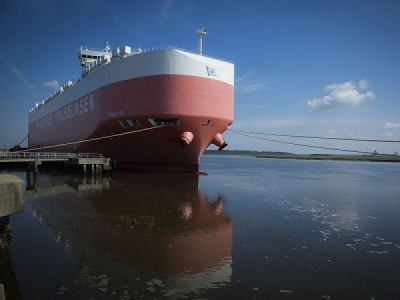
Posted on November 7, 2017
By Michael Hall, The Brunswick News
Honda moved 47,700 vehicles across the docks at the Colonel’s Island port terminal in the last fiscal year, nearly tripling the amount of cargo the company shipped through the Port of Brunswick, according to a release from port officials.
American Honda Motor Company added 34,700 vehicles to its traffic through the local port in fiscal year 2017, a move made largely because of expansion at the terminal and its proximity to the Atlantic Ocean, said Charles Kendig, assistant vice president for automobile operations at American Honda.
“Honda’s partnership with the Port of Brunswick is one of many bright spots in our finished vehicle supply chain,” he said in the release. “The port’s proximity to open ocean, its expansive and expandable capacity, the connections to our inland supply chain, award-winning auto processors and — perhaps most importantly — the complete alignment between state and local government on finding business-friendly solutions for shippers makes the Port of Brunswick an easy choice.”
The goodwill is equally as evident among port officials. Honda’s increase in volume was part of a 50 percent jump in business that made Brunswick the second busiest roll-on, roll-off port in the U.S. behind one in Baltimore, Georgia Ports Authority’s Executive Director Griff Lynch reported at a State of the Port luncheon in October on Jekyll Island.
“We’d like to thank Honda and International Auto Processing for their part in helping GPA move more than 600,000 vehicles through the Port of Brunswick last fiscal year,” Lynch said in the release Wednesday. “To ensure Brunswick continues to provide world-class service, GPA is expanding auto processing infrastructure to stay ahead of demand.”
The ports authority added 30,000 auto processing spaces in the last fiscal year, raising the total number available for use to 90,000, the release said. Wallenius Wilhelmsen, Mercedes and International Auto Processors already absorbed the the new space and increased operations by 200 acres, increasing total auto processing space to 600 acres on Colonel’s Island.
As the terminal continues to expand, the auto processing capacity potential could eventually reach 1.4 million units of anything that can be rolled onto a ship and off it — things like cars, trucks and tractors.
“Brunswick has an unmatched ability to scale up its operation so that we can grow along with our customers’ needs,” Lynch said.
That capacity may be necessary as ship size continues to grow, allowing companies to move more cargo. Today, ships can carry about 14,400 20-foot-equivalent units, a measurement commonly used in multimodal transportation. In 1998, the largest freighters could carry about 6,000 units.
To ensure the channel entering the Brunswick Harbor can handle the increased size, dredging will begin in December using about $10.3 million in federal dredging money for the Brunswick River went unused in the last fiscal year. Another $4.5 million in additional money was added this fiscal year, bringing the total to $14.8 million for channel maintenance.
Source: The Brunswick News





